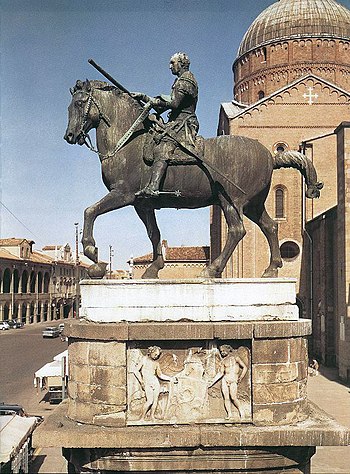Equestrian Statue of Gattamelata
| Equestrian statue of Gattamelata | |
|---|---|
 |
|
| Artist | Donatello |
| Year | 1453 |
| Type | Bronze |
| Location | Piazza del Santo, Padua, Italy |
 |
|
|
|
The Equestrian Statue of Gattamelata is a sculpture by Italian early Renaissance artist Donatello, dating from 1453, located in the Piazza del Santo in Padua, Italy, today. It portrays the Renaissance condottiero Erasmo da Narni, known as "Gattamelata", who served mostly under the Republic of Venice, which ruled Padua at the time.
After Erasmo of Narni's death in 1443, according to John Julius Norwich, the Republic of Venice, as a sign of gratitude and respect, paid for a sculpture in his honor. Measuring 340 x 390 cm (the base measuring 780 x 410 cm, it is the earliest surviving Renaissance equestrian statue and the first to reintroduce the grandeur of Classical equestrian portraiture. After its conception, the statue served as a precedent for later sculptures honoring military heroes.
The statue, as were all bronze statues of this time, was made using the lost wax method. The statue sits on a pedestal, and both the condottiero and his horse are portrayed in life size. Instead of portraying the soldier as larger-than-life, as in the classical equestrian statue of Marcus Aurelius in Rome, where a sort of hierarchy of size demonstrates the subject's power, Donatello used emotion, position, and symbolism to convey the same message. Thus, Donatello makes a statement of the power of the real-life individual; he does not need to embellish or make grander whom Gattamelata was – the simple depiction of the real man is enough to convey his power.
The pedestal under the horse is composed of two reliefs toward the top with fake doors underneath. The doors symbolize the gates of the underworld, lending the feeling of a tomb, though the monument was never a burial place. One relief shows Gattamelata's coat of arms flanked by two putti that are pointing to it. The other relief is of angels displaying battle armor.
Erasmo da Narni (Gattamelata) sits high on his horse, looking out to the distance. The emotion on his face is serious. Donatello portrays Gattamelata as a composed, alert and watchful leader. The depiction of force of character and the reference to the power of real people flows with the Renaissance themes of individualism and humanism.
...
Wikipedia
